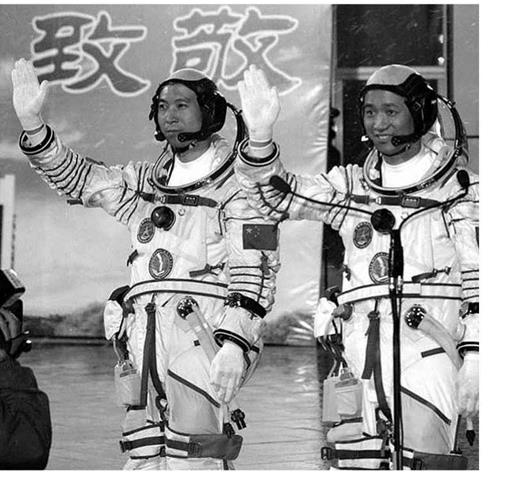. SHENZHOU 6
Flight Crew
FEI, Junlong, 40, Chinese PLA Air Force, commander NIE, Haisheng, 40, Chinese PLA Air Force, operator
Flight Log
Five pairs of yuhangyuans trained for the second Chinese manned space flight. One month prior to the flight, three pairs were selected to continue training, one as prime crew and two as back-ups. The prime crew was announced shortly prior to launch, with their back-ups announced as Liu Boming and Jing Haipeng (Team 1), and Zhai Zhigang and Wu Jie (Team 2). Nie and Zhai had backed up Yang two years before.
The timing, duration and objectives of the flight were discussed in the western media for months, before an official release indicated an October flight of about five days. Improvements had been made to the launch vehicle, whose assembly was completed on 26 September. The spacecraft was joined to the launch vehicle on 4 October. There had been over 110 upgrades to Shenzhou 6 over its predecessor, in four specific areas: upgrading the spacecraft to support the flight of two crewmembers; upgrading the internal configuration of the crew compartment; improvements to the safety systems; and improvements to the system components. In all, over 40 new items of equipment and six pieces of software were incorporated into the Shenzhou 6. There had also been over 75 upgrades to the launch vehicle since Shenzhou 5.
The crew had arrived at the launch site 2 hours 45 minutes prior to launch and were sealed inside their spacecraft about 30 minutes later. The launch was nominal, with powered flight lasting 583 seconds. Twenty-one minutes into the mission, the Shenzhou propulsion system was used to adjust the initial 200 km orbit to one of 211 x 345 km. Shortly after launch, search teams were dispatched to recover the telemetry “black box” ejected from the launcher during the ascent. It was thought
|
The Shenzhou 6 crew of commander Fei Junlong (left) and pilot/operator Nie Haisheng |
that it included telemetry that had not been downlinked to the ground. It was found 45 minutes after the launch.
During the flight, the two crew members conducted regular communication sessions with the ground, reporting on their personal condition and the status of the spacecraft, and speaking with their families. Several changes in orbital parameters were conducted during the five days in space, to test the operational capability of the Shenzhou orbital manoeuvring systems with a crew aboard. During the second orbit, the internal hatch into the OM was opened for the first time, and Fei was the first to enter. Three hours later, Fei swapped places with Nie. Very few details of the orbital activities of the crew were released, but the use of the OM and the extended flight allowed both men to take off their pressure suits for most of the orbital duration. Only one slept at any one time, however, with the second monitoring onboard systems.
The crew also shut and pressure-tested the internal hatch integrity, both for when the OM was separated and for the future when the OM would be used as an airlock to perform EVA. They also performed an experiment to test the reactions of the crew within the OM and DM, videotaping their somersaults and movement between the modules. The crew conducted a range of “scientific experiments”, which included Earth observation and monitoring, and research on “biological and material sciences.” Exact details were not forthcoming. The most important “experiment” in relation to future plans for EVA, docking, crew transfer and the creation of a small “space station”, was the habitability studies conducted throughout the five days by both men.
As with the previous Shenzhou mission, the OM was separated and left in orbit prior to entry and landing. The “mission” of the OM was officially ended on 15 April 2006 after nearly 3,000 orbits of the Earth, giving mission controllers experience in the extended control of a spacecraft in Earth orbit.
Milestones
246th manned space flight
2nd Chinese manned space flight
1st Chinese two-person space flight
1st extended manned test flight of Shenzhou
Nie Haisheng celebrates his 41st birthday in space (13 Oct)











